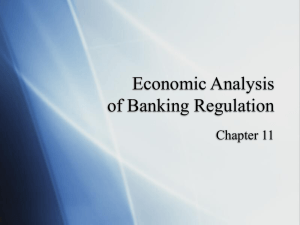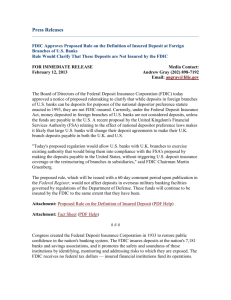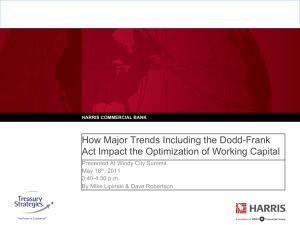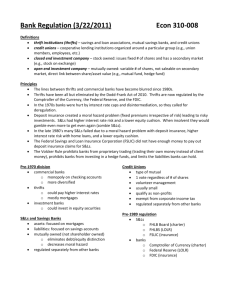Resolution Trust Corporation – A Governmentally Sponsored
advertisement
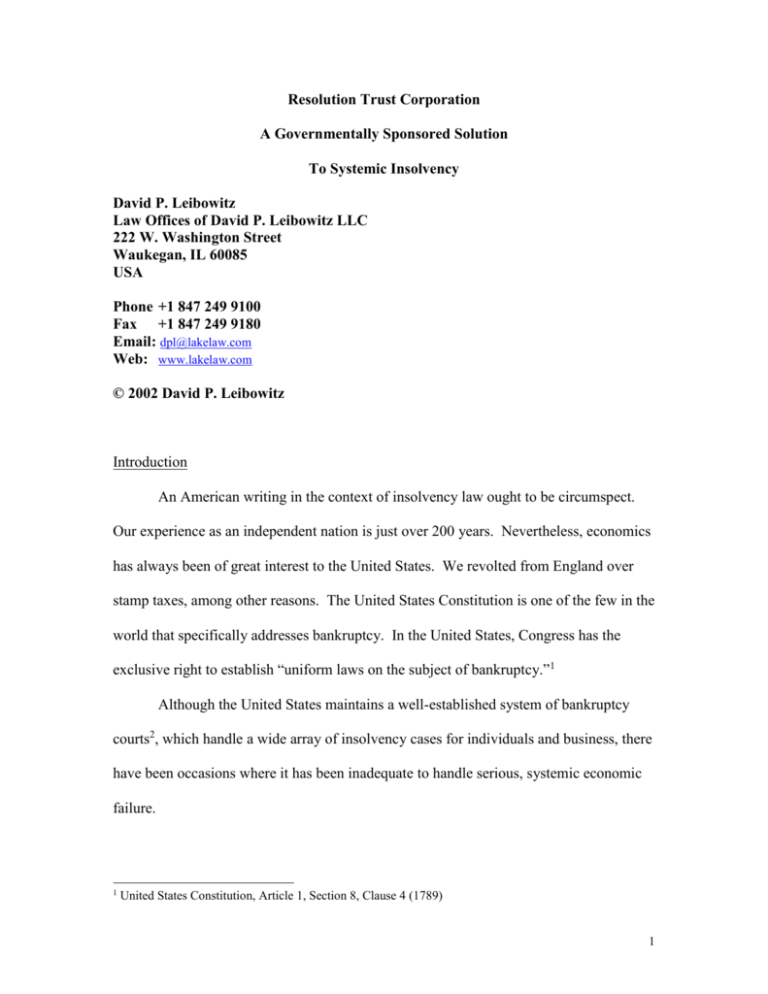
Resolution Trust Corporation A Governmentally Sponsored Solution To Systemic Insolvency David P. Leibowitz Law Offices of David P. Leibowitz LLC 222 W. Washington Street Waukegan, IL 60085 USA Phone +1 847 249 9100 Fax +1 847 249 9180 Email: dpl@lakelaw.com Web: www.lakelaw.com © 2002 David P. Leibowitz Introduction An American writing in the context of insolvency law ought to be circumspect. Our experience as an independent nation is just over 200 years. Nevertheless, economics has always been of great interest to the United States. We revolted from England over stamp taxes, among other reasons. The United States Constitution is one of the few in the world that specifically addresses bankruptcy. In the United States, Congress has the exclusive right to establish “uniform laws on the subject of bankruptcy.”1 Although the United States maintains a well-established system of bankruptcy courts2, which handle a wide array of insolvency cases for individuals and business, there have been occasions where it has been inadequate to handle serious, systemic economic failure. 1 United States Constitution, Article 1, Section 8, Clause 4 (1789) 1 The United States Bankruptcy Code3 applies generally to insolvent entities in the United States. However, many types of firms, such as domestic insurance companies and most banks, savings and loan associations and other bank-like organizations are not eligible for relief or reorganization under the Bankruptcy Code.4 Instead, banks and savings and loan associations are subject to federal or state regulation, depending upon whether they have a federal or state charter. In addition, they are subject to supervision of organizations such as the Federal Deposit Insurance Corporation5 (FDIC). The FDIC was established to protect depositors in light of the Great Depression of the 1930s. It established an insurance fund to protect depositors of insolvent banks. A similar fund was established for savings and loan associations, known as the Federal Savings and Loan Insurance Corporation (FSLIC). FDIC and FSLIC, along with the Federal Reserve Banks, the Office of the Controller of the Currency (OCC), the Office of Thrift Supervision (OTS), state regulatory agencies and others protected themselves from insurance claims by closely monitoring banks and bank activities. The objective has always been to insure safe and sound banking practices. For the most part, this regulation had been successful, with relatively few banking failures from the 1940s to the 1980s. However, from the later part of the 1980s, the United States experienced a banking crisis, especially in the savings and loan sector.6 From 1980 to 1994, almost 2 28 U.S.C. §151 establishes bankruptcy courts as a unit of the United States District Courts, the courts of primary jurisdiction in the federal system of courts. State courts have virtually nothing to do with bankruptcy in the United States. See generally 28 U.S.C. §§151 et seq. 3 11 U.S.C. §101 et seq. 4 11 U.S.C. §109(b) (d), United States Bankruptcy Code Section 109(b) and 109(d) 5 12 U.S.C. §1811(a). “There is hereby established a Federal Deposit Insurance Corporation (hereinafter the “Corporation”) which shall insure, as hereinafter provided, the deposits of all banks and savings associations which are entitled to the benefits of insurance under [the Federal Deposit Insurance Corporation Act]. 6 FDIC, History of the Eighties – Lessons for the Future: An examination of the Banking Crisis of the 1980s and Early 1990s (Washington, D.C.: Federal Deposit Insurance Corporation, 1997) 2 3000 banks or savings and loan associations failed or needed financial assistance. By 1987, the crisis was so extreme that the savings and loan insurance fund of FSLIC itself became insolvent. Congress dissolved FSLIC in 1989 and established the Resolution Trust Corporation on an emergency basis with the charter to resolve the banking crisis evoked by the massive failure of the savings and loan industry. The need for governmentally sponsored resolution to systemic insolvency is not unique to the United States or to the banking industry generally. For example, systemic resolution was a fundamental step to the reunification of Germany and the economically disparate East and West German economies.7 China today is faced with difficulties both in the banking sector and in the industrial sector. While China is developing a modern, commercially workable bankruptcy law, it is unlikely that such a legalistic approach will be successful in dealing with systemic economic failure such as is seen in the banking and state owned enterprise sectors of the Chinese economy. China is developing approaches utilizing “Asset Management Corporations” associated with the large banks to assist in the resolution of systemic insolvency in the Chinese economy. The recent experience of the United States in resolving systemic failure in the financial sector may well be instructive to developing economies faced with similar problems. Resolutions Process The Resolution Trust Corporation, established in 1989 to deal with the savings and loan and banking crisis in the United States, developed three basic ways to deal with (“resolve”) failed banks. The leading method was referred to as the “Purchase and 3 Assumption Agreement”. Under this scenario, a healthy financial institution would purchase the “good” assets of a failed financial institution and at the same time would assume the deposit liabilities. In this fashion, the depositors would find that they still had a bank that would honor their deposit liabilities and the FSLIC or FDIC would be relieved of insurance liability. The acquiring bank would be required to pay a premium for the “good assets” in exchange for the good-will acquired through the acquisition of an enhanced customer base. As a result, the losses associated with the bank failure would be reduced. While the Purchase and Assumption Agreement would result in the deposit liabilities being satisfied, other liabilities remained outstanding. These liabilities would be paid only to the extent that the FDIC or RTC in its role as receiver, would be successful in liquidating the “bad assets” of the failed bank. Non-depository creditors would have to file their claim in the receivership or other bank liquidation proceeding and would receive their pro-rata share from the liquidation of the “bad assets.” If a Purchase and Assumption Agreement could not be negotiated, usually because there were insufficient “good assets” or an insufficient customer base to justify one, the financial institution would be shut down. Depositors would receive insurance payouts to the extent of coverage and the balance would be paid to depositors or other unsecured creditors only to the extent of recovery on the “bad assets” in the liquidation. Such transactions are referred to as “Deposit Payoffs”. Cassell, Mark Kendrick A comparison of the Federal Republic of Germany’s Treuhandanstalt and the United States’ Resolution Trust Corporation (Madison, WI: University of Wisconsin, Madison Doctoral Thesis, 1998) 7 4 Sometimes, the insurance funds tried to forestall insurance liability by providing direct assistance to banks through so-called “Open Bank Assistance”. There are now significant statutory limitations on such a program and this is now rarely, if ever, utilized. The FDIC has published an extensive history and explanation of its approach to resolving failed financial institutions.8 This article borrows liberally from the FDIC’s excellent history of the resolution process. While the bank resolution process utilized by the RTC in the late 20th century appears to be specific to banks, it is really generally applicable to any systemic economic failure. And while the favored class of creditors protected by the Purchase and Assumption model in the United States was the depositor (as much to protect the insurance fund as to protect the depositor), the Purchase and Assumption model is just as viable to protect other favored classes of creditors, such as the workers in Chinese state owned enterprises. The Resolution Process Speed and transparency to the depositors was fundamental to the success of the resolution process, particularly under the Purchase and Assumption method. Depositors needed assurance that they still had a viable source for realization on their funds. The acquiring bank would have the opportunity to buy the franchise of the failed financial institution, including the customer base good will, only if it assumed the deposit liabilities. Ideally, the RTC (Resolution Trust Corporation), would attempt to get the acquiring institution to buy all the assets and assume all the liabilities of the failed bank. Usually, it was unable to find a buyer willing to do so. 5 There were certain classes of assets which the RTC and FDIC (“receiver”) never sold to the acquiring bank, such as claims against officers, directors, claims under bonds, insurance policies, claims against former attorneys, prepaid assessments and tax receivables. The acquiring bank also could put claims on forged or stolen instruments back to the receiver. In the later phases of the bank crisis in the United States, the RTC was more likely to conduct purchase and assumption agreements passing a greater share of the assets of the failed institution to the acquiring entity. The theory was that assets retained by the receiver were subject to a diminution in value just because they were viewed as damaged goods – this loss was referred to as the “liquidation differential.” From 1980 to 1994, the FDIC and later the RTC used purchase and assumption agreements to resolve 1,188 bank failures. There were several types of “P&A” transactions. Under the basic “P&A”, the acquiring bank only purchased cash and cash equivalents. However, it was to the benefit of the RTC to pass on as much as the asset base as the buyer was willing to pay for since the RTC’s costs of liquidation typically were greater than that of the private sector. This being the case, the RTC began to develop and conduct loan P&A agreements where current and performing loans were sold by the FDIC as receiver to the assuming bank. This type of P&A saved money because there were fewer loans for the RTC to administer. A further refinement of the loan P&A was a modified P&A where the buyer acquired a portion of the mortgage loan portfolio in addition to the performing commercial loan portfolio. Again, the more loans acquired, the easier it would be for the receiver to liquidate the “bad” assets. As the crisis deepened, RTC offered the acquiring 8 Resolutions Handbook available online at http://www.fdic.gov/bank/historical/reshandbook/index.html. 6 bank the opportunity to acquire even greater asset pools with the right to put the assets back if they could not be liquidated by the acquirer. Another strategy employed by the RTC was to establish asset pools of “bad assets” which could be acquired by the acquiring banks or others at a deep discount. Often the asset pools could result in realization to the RTC through an asset pool sale to a greater degree than would be possible if the RTC tried to liquidate those assets itself. Finally, the FDIC offered a program called “whole bank P&A” where the acquirer had to bid on the entire failed bank on a take-it-or-leave-it basis. While over 100 banks were sold this way, the “whole bank” strategy was flawed and resulted in lower than average returns to the FDIC and the failed banks’ creditors. Loss-sharing purchase and assumption agreements were aggressively utilized by the FDIC to induce acquiring banks to buy a failed institution on short notice and with little due diligence. The FDIC agreed to cover a portion of the losses that the acquiring institution might suffer as a result of purchasing the portfolio of a failed bank, especially its real estate portfolio. In practice, this turned out to be a useful approach. In the period from 1991 to 1993, about 15 such transactions took place, from Southeast Bank in Miami Florida to several branches of First City Bank in Texas; from First New Hampshire Bank in New Hampshire to Meritor Savings Bank in Philadelphia, PA. The size of these transactions ranged from $225 million to $10 billion. On the average, the costs of resolution of these banks was a mere 6%, an outstanding result. Bridge Banks Sometimes, FDIC could not locate a buyer very quickly for a failed bank. Something had to be done to keep depositors happy in the meantime. The answer was to 7 establish a bridge bank – a bank operated by the FDIC to protect the customers long enough to stabilize the situation and to allow the FDIC to find another entity willing to acquire the failed banks and its assets. Under United States law, the bridge bank could operate only 2 years with 3 oneyear extensions. Thereafter, the bridge bank had to be sold or otherwise resolved. Bridge banks were not the method of choice to resolve failed institutions. But they were successful in dealing with larger than average or very complicated deals. The bridge bank technique was most notably used in resolving First City Bank and First Republic Bank in Texas. Over $89 billion in assets were resolved using bridge banks. “Too Big to Fail” At least one United States bank was simply rescued by the FDIC because it was too big to fail. All the stockholders in this bank, the grandiosely named Continental Illinois National Bank and Trust Company (including your author), lost their entire investment. However depositors lost not one dime, even though the bank lost its shirt in the notorious Penn Square oil patch debacle and in a subsequent run on the bank. Although the Continental had $40 billion in assets, $5 billion of that was tied up in Penn Square. The FDIC purchased Continental’s bad loans, injected close to $2 billion. Although Open Bank Assistance transactions received a lot of criticism, the FDIC resolved close to 120 banks in this manner. Conclusion The FDIC and Resolution Trust Corporation model for rescuing and restoring failed financial institutions illustrates lessons generally applicable to other economies and to other economic sectors. 8 1. Speed counts. The normal purchase and assumption agreement is fast and results in a prompt resolution of a problem or failed economic unit. 2. The purchasing entity protects favored creditors and pays a premium for acquiring the franchise represented by the failed business. 3. The assuming entity should be encouraged to acquire as many of the assets of the failed entity as it can reasonably do. The more residue to resolve, the less likely that favorable collections will follow. 4. The governmental agency must have the wherewithal to operate the business on an interim basis while a buyer is located (utilizing the bridge bank model). 5. Some banks may be “too big to fail” and an infusion of capital may be favorable to outright failure. 6. The purchase and assumption agreement is a flexible device and can be adapted to maximize the return on the troubled assets. 9
